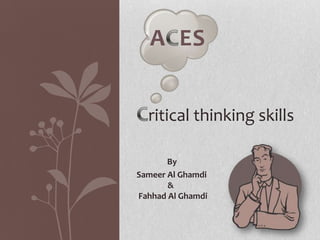
Develop Critical Thinking Through Lesson Planning
- 1. A ES ritical thinking skills By Sameer Al Ghamdi & Fahhad Al Ghamdi
- 2. • Engaging students in critical thinking known as a higher level thinking, its not only motivational, it is the best way that we can prepare our students for postsecondary education. • The engagement of the mind makes learning enjoyable for students and class time flies. • The ability to think critically about content and to analyze, synthesize, draw inferences , and evaluate sources are identified as important skills across the curricula. • Before infusing critical thinking in a lesson, its important that we develop a structure for lesson planning.
- 3. • Good teaching begins with thoughtful planning if you want to produce a really outstanding lesson. • The basic model of the lesson plan, based on Hunter’s step model: 1) Stated Objectives – Letting students know where they are going. 2) Anticipatory Set – an activity, a game, a discussion, exercise, etc. 3) Input Modeling/Modeled Practice Making sure students get it right. 4) Guided Practice - Making sure students have it right! 5) Closure - Bringing it all to a close - What did they learn? 6) Independent Practice - Doing it by themselves.
- 4. • In 1956, Benjamin Bloom developed a classification of levels of intellectual behavior important in learning. • The next graphic shows the original Taxonomy. (High complex) Evaluation Present and defend opinions by making judgments about info. Synthesis Compile information together in a different way. Analysis Elements, relationships, and organizational principles. Application Using new knowledge. Solve problems in new situations. Comprehension Translation, Interpretation, Extrapolation. Knowledge Recalling facts, terms, basic concepts and answers. (less complex)
- 5. • During the 1990's Lorin Anderson (a former student of Bloom), updated the taxonomy to reflect relevance to 21st century work. • The next graphic shows the revised Taxonomy (Cognitive). Creating Can the student create new product or point of view? Evaluating Can the student justify a stand or decision? Analyzing Can the student distinguish between the different parts? Applying Can the student use the information in a new way? Understanding Can the student explain ideas or concepts? Remembering Can the student recall or remember the information?
- 6. The Knowledge Dimension Knowledge type Description The basic elements students must know such as Factual Knowledge terminology, definitions, dates, etc. Conceptual Knowledge Knowledge of the relationships that connect elemental facts into big ideas. . Procedural Knowledge How to do something, such as solving a problem, and knowledge of skills, methods. Knowledge of thinking in general as well as Metacognitive Knowledge awareness and knowledge of one’s own cognition .
- 7. • Bloom’s Taxonomy of the Cognitive Domain is a powerful tool in helping us design lessons that develop the thinking skills of our student. • Its also can be used not only to help create objectives that support high student achievements, but as a tool to check for consistency among objectives, activities, and assessment (Anderson & Krathwohl, 2001)
- 8. • Internalize the taxonomy until you remember it. • Understand the taxonomy by reading about it. • Apply your conceptual knowledge by creating objectives that reflect different levels of cognitive complexity. • Analyze your lessons both by complexity and knowledge type. • Evaluate the lesson. • Create lessons and units that build the critical thinking skills that our students need.